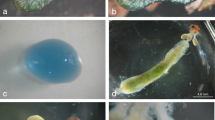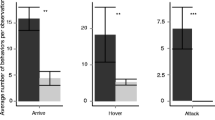Abstract
The lycaenid butterfly,Eumaeus atala, was found to contain cycasin, an azoxyglycoside, by thin-layer chromatography (TLC). Quantification of cycasin content in 10 individual freshly killed and frozen males and females, using capillary gas chromatography (GC), showed that cycasin contents of individual butterflies ranged from 0.21 to 0.51 mg (1.24–2.75% dry weight). A museum specimen ofE. atala of unknown age had undetectable amounts of cycasin by GC. GC showed that larval frass contained about 0.10% cycasin, which was not detectable by TLC. Cycasin in the host plant was not detectable by TLC but was detected by GC and found to be 0.02% dry weight. There was no macrozamin, another azoxyglycoside characteristic of many cycads, in the butterfly or plant. Feeding trials with a colony of the ant,Camponotus abdominalis floridanus, showed that both cycasin and the adult ofE. atala were deterrent to the ants.
Similar content being viewed by others
References
Atsatt, P.R. 1981. Lycaenid butterflies and ants: Selection for enemy-free space.Am. Nat. 118:638–654.
Brower, L.P. 1984. Chemical defense in butterflies, pp. 109–134,in R.I. Vane-Wright and P.R. Ackery (eds.). The Biology of Butterflies, Symposium of the Royal Entomology Society, Number 11. Academic Press, New York.
De, Luca, P., Moretti, A., Sabato, S., andGigliano, G.S. 1980. The ubiquity of cycasin in cycads.Phytochemistry 19:2230–2231.
Devries, P.J. 1976. Notes on the behavior ofEumaeus minyas in Costa Rica.Brenesia 8:103.
Devries, P.J. 1977.Eumaeus minyas, an aposematic lycaenid butterfly.Brenesia 10:269–270.
Eliot, J.N. 1973. The higher classification of the Lycaenidae (Lepidoptera): A tentative arrangement.Bull. Br. Mus. Nat. Hist. Entomol. 28:373–505.
Gardner, D.R. 1987. Iridoid glycoside chemistry of someCastilleja andBesseya plants and their hosted checkerspot butterflies. PhD dissertation. Colorado State University, Fort Collins, Colorado.
Hooper, P.T. 1978. Cycad poisoning in Australia—etiology and pathology, pp. 337–347,in R.F. Keeler, K.R. van Kampen, and L.F. James (eds.). Effects of Poisonous Plants on Livestock. Academic Press, New York.
Howe, W.H. 1975. The Butterflies of North America. Doubleday and Co., New York.
Lenczewski, B. 1980. Butterflies of Everglades National Park. South Florida Research Center Report T-588. 110 p.
Matsumoto, H., andStrong, F.M. 1963. The occurrence of methylazoxymethanol inCycas circinalis L.Arch. Biochem. Biophys. 101:299–310.
Miller, J. 1986. Phylogeny and classification of the Castniidae. Presentation at 1986 meeting of the Lepidopterist's Society, Ottawa, Canada.
Moretti, A., Sabato, S., andGigliano, G.S. 1983. Taxonomic significance of methylazoxy- methanol glycosides in the cycads.Phytochemistry 22:115–117.
Pasteels, J.M., Daloze, D., andRowell-Rahier, M. 1986. Chemical defense in chrysomelid eggs and neonate larvae.Physiol. Entomol. 11:29–37.
Pierce, N.E. 1983. The ecology and evolution of symbioses between lycaenid butterflies and ants. PhD dissertation. Harvard University, Cambridge, Massachusetts, 273 pp.
Rawson, G.W. 1961. The recent rediscovery ofEumaeus atala (Lycaenidae) in southern Florida.J. Lepid. Soc. 15:237–244.
Robbins, R.K. 1980. The lycaenid “false head” hypothesis: Historical review and quantitative analysis.J. Lepid. Soc. 34:194–208.
Robbins, R.K. 1981. The lycaenid “false head” hypothesis: Predation and wing pattern variation of lycaenid butterflies.Am. Nat. 118:770–775.
Rothschild, M. 1985. British aposematic Lepidoptera, pp. 9–62,in J. Heath and A.M. Emmet (eds.). The Moths and Butterflies of Great Britain and Ireland. Harley Books, Essex, England.
Rothschild, M., Nash, R.J., andBell, E.A. 1986. Cycasin in the endangered butterfly,Eumaeus atala florida.Phytochemistry 25:1853–1854.
Seitz, A. 1924. The Macrolepidoptera of the World. Alfred Kernen Verlag, Stuttgart.
Teas, H.J. 1967. Cycasin synthesis inSeirarctia echo (Lepidoptera) larvae fed methylazoxymethanol.Biochem. Biophys. Res. Commun. 26:686–690.
Teas, H.J., Dyson, J.G., andWhisenant, B.R. 1966. Cycasin metabolism inSeirarctia echo Abbot and Smith (Lepidoptera: Arctiidae).J. Ga. Entomol. Soc. 1:21–22.
Wilson, E.O. 1971. The Insect Societies. Belknap Press, Cambridge, Massachusetts.
Yagi, F., Tadera, K., andKobayashi, A. 1980. Simultaneous determination of cycasin, methylazoxymethanol and formaldehyde by high performance liquid chromatography.Agric. Biol. Chem. 44:1423–1425.
Author information
Authors and Affiliations
Rights and permissions
About this article
Cite this article
Bowers, M.D., Larin, Z. Acquired chemical defense in the lycaenid butterfly,Eumaeus atala . J Chem Ecol 15, 1133–1146 (1989). https://doi.org/10.1007/BF01014817
Received:
Accepted:
Issue Date:
DOI: https://doi.org/10.1007/BF01014817




